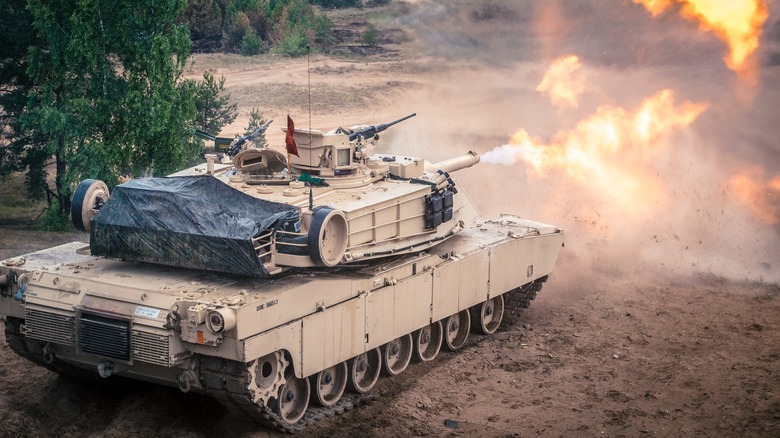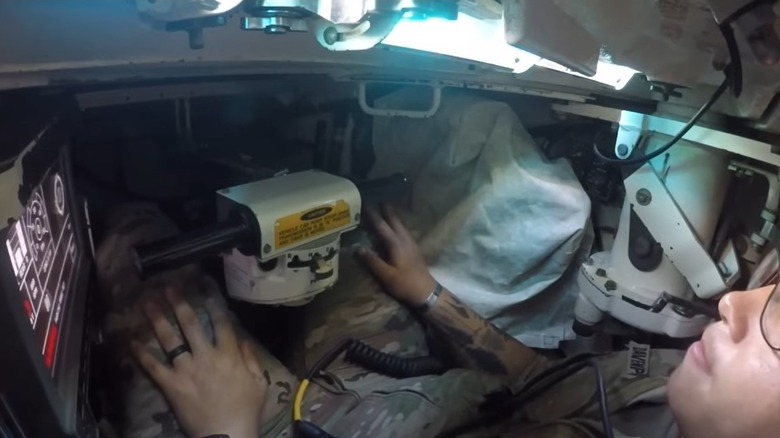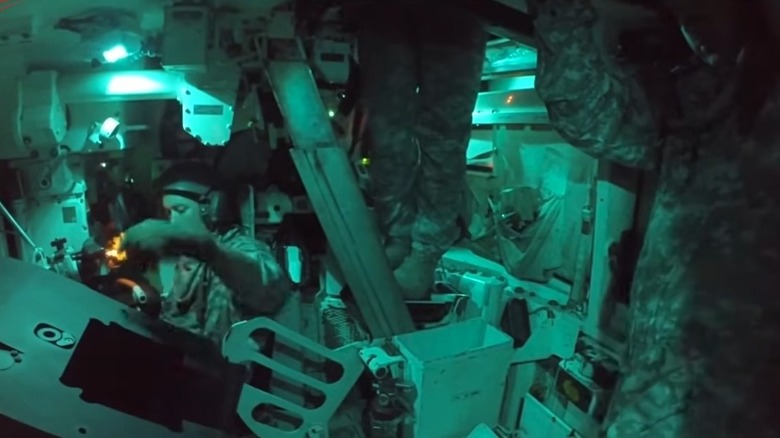What Does The Inside Of An M1 Abrams Tank Look Like?
From the outside, the M1 Abrams battle tank looks like a bit of a behemoth, and statistics confirm this — the M1A2 variant of the type weighs in at 67 tons, is just under 32 feet long, and is over 12 feet wide. You'd think that a vehicle of this size would have room aplenty for its crew. However, despite all this weight and girth, the tank is surprisingly cramped inside. The M1 Abrams has been a mainstay of the US Army for over forty years, and over this time, a lot of men and women have discovered for themselves just what the inside of an M1 Abrams is like.
The M1 Abrams is crewed by four soldiers — the commander, driver, gunner, and loader. The driver occupies their own compartment situated just to the front of the turret. This is considered the most comfortable seat in the tank, and drivers often leave the hatch open to enjoy the wind, so you could argue that the M1 Abrams is also a convertible. Space inside the turret is at a premium, and crew members quickly learn practical hacks — like wearing wristwatches with the face on the inside to avoid cracking them on the cramped interior. So, what exactly does it look like inside an Abrams? Let's crack open the hatches and take a closer look.
M1 Abrams: In the driver's seat
Stepping inside an M1 Abrams tank — one of the most famous military vehicles ever – is something that very few of us mere mortals will experience. However, thanks to YouTube's USA Military Channel, we can now get a crew perspective of what it's like inside one of these fearsome battle tanks. The driver sits in an isolated compartment in a reclined posture that's like a cross between an IndyCar or F1 seating position and that of a dentist's chair. However, rather than a steering wheel, the driver uses a motorcycle-like handlebar to steer the tank and handlebar throttle grips to control the speed; it also features a familiar brake pedal on the floor. Visibility is provided by three periscopes (or vision blocks) — a central periscope, and two side periscopes, one of these can be swapped for a night vision periscope. The night vision periscope can also be used to intensify images in other low-light conditions like mist, dust, or smoke. In total, these give the driver a 120-degree forward-facing range of vision.
As well as the periscopes, the driver also monitors a driver-integrated display (DID). This is a digital instrument panel that can act as a navigation aid, as well as perform other familiar "wheeled-vehicle" stuff like a speedometer, fluid monitoring, and providing engine performance data. According to one crewman speaking to Business Insider, the tank is incredibly easy and intuitive to drive. He also noted that it makes the perfect place to take a nap.
Inside the turret of an M1 Abrams
The turret is where the other three crew members spend their time. The first thing to note is the color; unlike the camouflaged exterior, the inside is painted white. This is to make sure that visibility is as good as possible in low-light conditions. Inside the turret — or the turret basket as it's also known – sit the commander, the loader, and the gunner. And it's in here that things begin to get cozy. Starting with the gunner, the gunner sits at the bottom-right of the turret and has access to a stabilized sight with night-vision capabilities and a laser rangefinder.
To the gunner's left sits the loader. As the name suggests, it's their job to load the gun. This is usually done from a standing position with the ammunition retrieved from behind them and loaded into the gun. Despite the cramped conditions, a good loader will load a round in under seven seconds. Finally, we can look at the commander's position. They sit to the right of the tank and behind the gunner. The commander has 360-degree vision thanks to the station being equipped with six periscopes. These also have independent stabilization, automatic sector scanning, and backup fire control. Life inside the turret is loud, cramped, hectic, and not for the faint-hearted or claustrophobic. The M1 Abrams might have weaknesses, but it's an environment where teamwork and precision are as essential as the purity of design that has kept the M1 Abrams relevant on modern battlefields.


